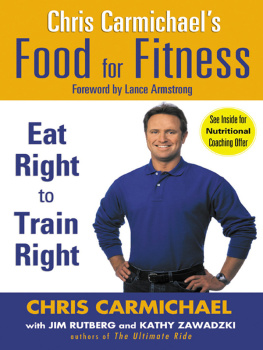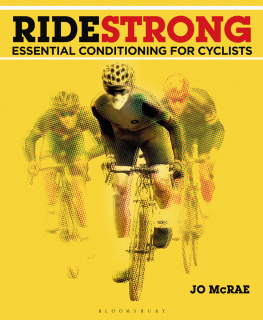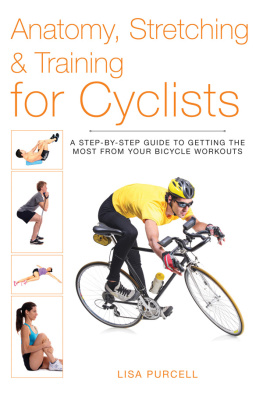Table of Contents
B
BERKLEY BOOKS
TO ED BURKE,
whose knowledge was surpassed only by his humanity
Introduction
THE FIRST TIME I met Chris Carmichael, there was one big question I wanted to ask. It was the spring of 1999, a few months before Lance Armstrongs first Tour de France victory and the founding of Carmichael Training Systems. Chris had been my coach since the beginning of the year, but it was April before I met him on a trip to Colorado. He invited me up to his house for dinner, and within five minutes of stepping through his front door I asked, Does a great coach produce great athletes, or is it the athletes that make the coach great?
You see, Chris had only been my coach for a few months, and I was riding well, but not that much better than I would have been anyway. Besides his reputation, I didnt have any real proof that Chris was a great coach. Sure, he was Lances coach, George Hincapie had introduced us, and he had coached the U.S. Olympic team, but the question still stood: Would those athletes have been just as successful regardless of whom they called Coach? Did Chris help them become great athletes, or did their greatness elevate Chriss coaching reputation just by association?
My question stopped Chris in his tracks: actually, it seemed like the whole house froze, and he asked me if I realized I had just questioned the validity of his and all coaches careers. Suddenly I realized that my seemingly academic question was profoundly insulting. I had inadvertently stripped coaching of its worth and accused him of exploiting the athletes he worked with to further his career. The evening was not going anywhere near the way I had planned it.
Chris poured us each a glass of wine and set about answering my question. He said athletes are like students and coaches are their teachers. A talented and intelligent student has the tools to learn but needs instruction and guidance to become a scholar. Likewise, athletes like Lance Armstrong have the talent and drive to excel in cycling, but they need the same instruction and guidance to become champions. Would Lance have been a great cyclist without Chris? Chriss answer was yes. Had Chris improved Lances performance beyond what he would have been capable of by himself? Again his answer was yes.
In the months that followed, I began to see the benefits of working with Chris. There was nothing earth-shattering about the training programit was a sound program based on periodization and the principles and components of training. It was the instruction and guidance he mentioned over wine and dinner that night that made the difference. Chris challenged me to change the way I approached racing and training. I lacked confidence in my ability to ride aggressively, go off the front, and challenge riders I perceived to be better than I was. He used many of the same ideas youll find in this book to show me how to find the confidence I needed to succeed. In a few weeks, I went from the back of the field to standing on the podium, and it had nothing to do with a change in my fitness. Maybe there was something to this whole coaching thing....
I interned at CTS in the fall of 1999 and have been working here ever since. I made the transition from athlete to coach, and some time later Chris told me his first impression had been that I was a talented athlete but was a head case. I was surprised, because I had thought my fitness and skills were what needed help, not my approach to racing. He had seen that I had the strength and talent to succeed but that I didnt know how to make the most of them. In the end, I had achieved what Chris always knew I was capable of. What he had done only dawned on me later, after I had been coaching for a while. It turns out that the art of coaching involves guiding athletes to discover, on their own, what the coach already knows.
For three years I have worked alongside an unparalleled group of endurance coaches: Dean Golich, Craig Griffin, Chris Carmichael, Jim Lehman, Mike Niederpruem, and Lance Watson. Ive seen them guide athletes through the same transformation that Chris helped me through, and they taught me to do it, too. Yet through it all, the question I asked Chris that night at his house still churned in my head: Which comes first, the great athlete or the great coach? Who makes whom?
The complete answer is somewhere in the middle. Talented athletes and coaches exist independently of each other. The mark of a great coach is the ability to improve any athletes level of performance, regardless of that athletes starting point. And when you combine the strengths of a great coach with the talent and drive of a great athlete, you create legends.
Jim Rutberg
From the Ground Up
LONG BEFORE I THOUGHT of cycling in terms of fitness or competition, riding my bike offered freedom and a fun way to get from here to there. Some of my best memories from early childhood are of riding with a buddy from my house in South Miami, Florida, to Biscayne Bay. It was just a three-mile cruise each way, but it was an adventure to cover what seemed like a lot of territory. As I grew up and became a competitive racer, I never lost the sense of freedom and adventure I first enjoyed. Cycling has taken me around the world, introduced me to incredible people, and helped me develop a career through which I can positively affect the lives of many others by helping them reach their dreams.
When I was growing up in southern Florida in the 1960s, I was lucky that there was a well-developed cycling community. The large numbers of Cuban immigrants had brought their love for cycling with them when they settled in Miami, and there were plenty of cycling clubs, group rides, and training races. One of the local events, the Tour of Coconut Grove, was my first taste of competition. I entered the race for the first time at nine years of age. It was a 10-years-old-and-under criterium and although I didnt really know what I was doing, I had a lot of fun and ended up finishing third. At such a young age, getting a trophy was a great feeling and I was completely hooked on bike racing.
I started riding my bicycle everywhere, including back and forth to and from school. One afternoon when I was 12, I stopped at a local arcade on the way home from school, locked up my bike, and went in to play pinball. When I left the arcade to go home, I found that someone had stolen my bike. I was particularly upset because I had convinced my parents to buy me a $90 bike and now I had lost it. Dade Cycle Shop was right next to the arcade, and I immediately went into the shop and asked for a job. I wanted to be able to go home and tell my dad I had lost my bike, but that Id also gotten a job to pay for a new one.
Dade Cycle Shop was a racers bike shop; they had Colnago bicycles hanging in the racks and racers working as mechanics. There wasnt much I knew how to do, but the owner, Joe Avalos, gave me a job after school fixing flat tires and sweeping up around the place. He had a couple of conditions for employing me. He told me not to talk too much and that if he found out my grades were suffering he would fire me. I think my starting salary was $1 an hour. Since I was the youngest person hanging around the shop, I quickly earned the nickname The Kid, which has stuck with me to this day. Lance Armstrong still begins a conversation with me by saying, Hey, Kid, hows it goin?







![Cotter - Kettlebell training: [95 exercises for strength, toning, stamina, and weight loss]](/uploads/posts/book/196732/thumbs/cotter-kettlebell-training-95-exercises-for.jpg)





